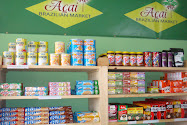Documentation of traditional Camu Camu uses is scarce. It is unlikely that in traditional Amazonian societies Camu Camu has ever been nutritionally relevant. The fruit is extremely acidic, and the flavour can only be appreciated in recipes requiring a blender, dilution in milk/water and the addition of sugar.
The extraordinarily high Vitamin C content (in the order of 2-3% of fresh weight) is the most important property of the Camu Camu fruit, which has been exploited consistently in positioning Camu Camu on international markets. Vitamin C content declines as full maturity is reached, and there is a trade-off between Vit C and flavour expression. As a myrtaceous fruit, Camu Camu most likely provides other nutritional benefits (phenolics, etc.,), but these are less understood and communicated to consumers.
Camu Camu has also a unique aroma and fruit pigmentation. A reddish pigment in the leathery skin (probably anthocyanins) imparts an attractive and unique pink color on juices extracted from Camu Camu. The aroma is subtle, but is not as captivating as in more popular fruits. Camu Camu is more recently also used in ice creams, sweets, etc.
Processed powder from the fruit pulp is beginning to be sold in the west as a health food in loose powder or capsule form. In addition to the high Vitamin C content it contains the amino acids valine, leucine and serine, and is also rich in flavonoids.
[edit] Constraints to the expansion of current use
Price. At FOB prices in Peru soaring to USD 3500 per ton of single-strength juice, Camu Camu is 4-5 times more expensive than comparable fruit pulps and even concentrates. The high price of Camu Camu is a consequence of the difficult logistics involved in production for off-site consumption. The fruits are locally collected, processed and frozen, then shipped to Lima, and exported via ocean freight. The high price of Camu Camu obviously limits demand.
As a source of Vitamin C Camu Camu is several orders of magnitude more expensive than pure synthetic Vitamin C. Obviously, marketeers emphasize that Camu Camu contains “natural” Vitamin C capitalizing on the recent study (Nov 2008) which shows its superior action over synthetic vitamin C in the area of Heart Health.[1]
Competition from natural sources of Vitamin C. Concentrates and extracts of rose hips, acerola (another myrtaceous fruit) are less expensive per unit of Vitamin C, probably because of economies of scale.
Irregularity of quality and timing of raw material supplies from wild populations. Prices paid to fruit collectors on the Rio Napo in Peru in Jan 2006 soared to one USD/kg fresh fruit because of drought-induced low harvests. Local markets are still able to pay such prices for limited quantities, but local processors and exporters have been put out of business, at least until prices relax to make the purchase of raw material affordable again. Exporters insure themselves against irregular raw material supplies by maintaining large stocks of frozen finished produce, but this further adds to cost.
Food safety legislation in export markets. As a food product Camu Camu has probably not been available in the EU prior 1997 and may therefore be subject to the Novel Food Regulation (NFR), which requires very stringent food safety requirements to be met before a product is granted access to the community’s market. The scientific documentation as to the toxicity, nutritional composition and potential allergenic hazards required by NFR is currently not available. The NFR has discouraged investment in export-oriented supply chains and has emerged as a serious constraint to many NUS products (see external links to GFU documentation, Hermann 2004).
[edit] Conservation issues
Currently, the over-harvesting of wild Camu Camu threatens to make it an endangered species. Efforts are underway to encourage the commercial growing of Camu Camu in the Amazon River Basin. see links.
[edit] Future prospects
Camu Camu is a species with promising potential, but unknown in target markets. A concerted effort is needed to advertise Camu Camu products, and to make the species more competitive vis-à-vis its substitutes.
Because of its endemic nature and possibly narrow ecological adaptation providing a certain degree of protection against competitors, Camu Camu merits prioritization by regional governments and allocation of resources for further development.
Progress toward more competitive cropping of Camu Camu in plantations (as opposed to wild collecting), however, might compromise benefits to rural people now deriving benefits from collecting fruits from the wild.
Myrciaria dubia, commonly known as Camu Camu, CamuCamu, Cacari, and Camocamo, is a small (approx. 3-5 m tall) bushy river side tree from the Amazon Rainforest vegetation in Peru and Brazil, which bears a red/purple cherry like fruit. Its small flowers have waxy white petals and sweet smelling aroma. It has bushy feathery foliage. The evergreen, opposite leaves are lanceolate to elliptic. Individual leaves are 3 - 20 cm in length and 1 - 2 cm wide.
It is a close relative of the Jaboticaba (Myrciaria cauliflora) and the Guavaberry or Rumberry (Myrciaria floribunda).
Subscribe to:
Post Comments (Atom)




No comments:
Post a Comment